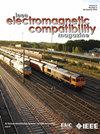多导体传输线求解器与电路求解器Ngspice的杂交处理线路互连和终端
IF 2.5
3区 计算机科学
Q3 ENGINEERING, ELECTRICAL & ELECTRONIC
IEEE Transactions on Electromagnetic Compatibility
Pub Date : 2025-04-28
DOI:10.1109/TEMC.2025.3560361
引用次数: 0
摘要
本文提出了一种多导体传输线(MTL)求解器的杂交方法,该方法采用时域有限差分法实现,电路求解器ngspice用于处理传输线的终端和互连。mtl中的瞬态分析和串扰已经得到了广泛的研究,但线路终端和线路之间的连接大多局限于集总电阻、电感和电容(RLC)元件。然而,现实的系统,如电力分配或通信系统,通常涉及更复杂和先验未知的连接。通过将MTL求解器与电路求解器集成,所提出的方法可以包含电路模型可以编写或已经存在的任何组件,即色散元件,如铁氧体,和电子元件,如二极管,放大器或晶体管。这种能力使得用电路模拟复杂的MTL网络成为可能,包括非线性的终端和互连。通过与实验室测量结果的比较,验证了该方法的有效性。本文章由计算机程序翻译,如有差异,请以英文原文为准。
Hybridization of Multiconductor Transmission Line Solver With Circuit Solver Ngspice to Treat Line Interconnections and Terminations
This article presents the hybridization of a multiconductor transmission line (MTL) solver, implemented using the finite-difference time-domain method, with the circuit solver ngspice to treat the terminations and interconnections of transmission lines. Transient analysis and crosstalk in MTLs have been widely studied, but the line terminations and the connections between lines are mostly restricted to lumped resistors, inductors and capacitors (RLC) components. However, realistic systems, such as power distribution or communication systems, typically involve more complex and a priori unknown connections. By integrating the MTL solver with a circuit solver, the proposed approach enables the inclusion of any component for which a circuit model can be written or already exists, i.e., dispersive elements, such as ferrites, and electronic components, such as diodes, amplifiers, or transistors. This capability makes it possible to simulate the MTL networks with complex, including nonlinear, terminations and interconnections modeled by circuits. The proposed method is validated through comparison with experimental laboratory measurements.
求助全文
通过发布文献求助,成功后即可免费获取论文全文。
去求助
来源期刊
CiteScore
4.80
自引率
19.00%
发文量
235
审稿时长
2.3 months
期刊介绍:
IEEE Transactions on Electromagnetic Compatibility publishes original and significant contributions related to all disciplines of electromagnetic compatibility (EMC) and relevant methods to predict, assess and prevent electromagnetic interference (EMI) and increase device/product immunity. The scope of the publication includes, but is not limited to Electromagnetic Environments; Interference Control; EMC and EMI Modeling; High Power Electromagnetics; EMC Standards, Methods of EMC Measurements; Computational Electromagnetics and Signal and Power Integrity, as applied or directly related to Electromagnetic Compatibility problems; Transmission Lines; Electrostatic Discharge and Lightning Effects; EMC in Wireless and Optical Technologies; EMC in Printed Circuit Board and System Design.

 求助内容:
求助内容: 应助结果提醒方式:
应助结果提醒方式:


